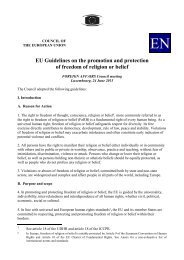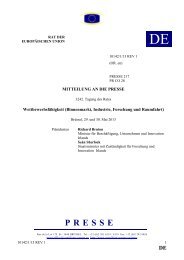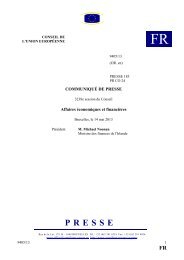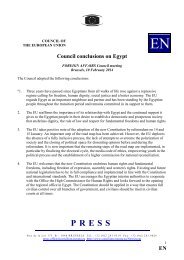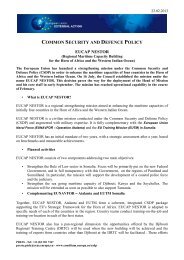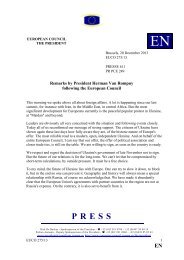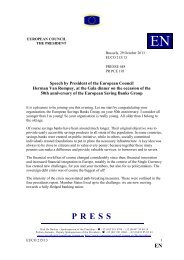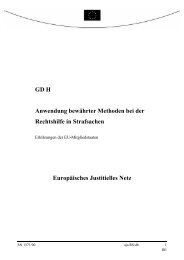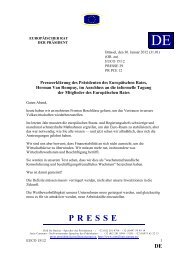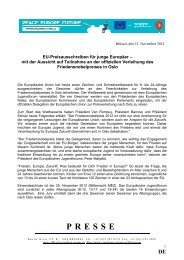14508/09 ADD 1 PL/vk 1 DG G COUNCIL OF THE ... - Europa
14508/09 ADD 1 PL/vk 1 DG G COUNCIL OF THE ... - Europa
14508/09 ADD 1 PL/vk 1 DG G COUNCIL OF THE ... - Europa
Create successful ePaper yourself
Turn your PDF publications into a flip-book with our unique Google optimized e-Paper software.
overall. Today girls and women have an overall higher educational attainment than men. Girls and<br />
women (but not boys and men) have diversified their range of choices in scientific areas. Women<br />
predominate in teacher training and education, health and welfare, arts and humanities, agriculture<br />
and veterinary studies, and business, administration and law, and men predominate in science,<br />
mathematics and computing and in particular in technical studies, engineering and construction at<br />
ISCED 5-level. Men predominate in all areas at ISCED 6-level. However, there is an increase in the<br />
number of women succeeding at higher levels in non-traditional subjects.<br />
In several MS stereotyped views of women and the impact of such stereotypes on educational<br />
choices have been addressed through projects consisting of training of teachers and other relevant<br />
education professionals, including through projects aiming at raising awareness of gender equality<br />
approaches and strengthening the competencies for the promotion of gender equality. One report<br />
(IE) mentions a booklet for students which provides examples of activities and ways in which<br />
students can contribute to their school’s gender equality policy and to gender mainstreaming.<br />
Portugal reports that it has been investing in mainstreaming gender and addressing gender<br />
stereotypes in education for many years.<br />
Several countries implement projects to encourage girls to pursue new career paths such as<br />
entrepreneurship and technology, many fewer MS mention projects encouraging boys to break<br />
stereotypes, however, there are reports (CY, DE) of projects aimed at encouraging boys to become<br />
more involved in family and private life.<br />
In a number of reports, special educational needs are mentioned in relation to migrants, Roma and<br />
disabled people; it is also reported that while girls from ethnic minority groups perform better<br />
educationally and have higher scores than boys with the same background, they are still lagging<br />
behind girls of native origin (example from NL).<br />
References<br />
Council Conclusions May 2007 + Annex (Women and Education)<br />
European Commission: She Figures 2006<br />
European Foundation for the Improvement of Living and Working Conditions, The narrowing education gap between<br />
women and men 2008<br />
<strong>14508</strong>/<strong>09</strong> <strong>ADD</strong> 1 <strong>PL</strong>/<strong>vk</strong> 63<br />
ANNEX <strong>DG</strong> G EN



